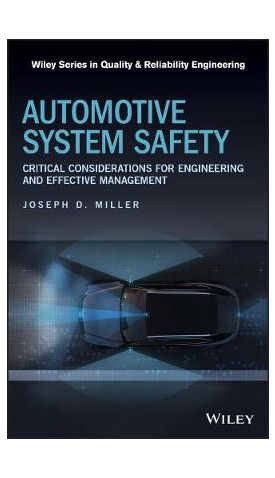אנו משתמשים ב-Cookies כדי לשפר את החוויה שלך. כדי לקיים ההנחיה החדשה של e-Privacy, עלינו לבקש את הסכמתך להגדיר את ה-Cookies. קבלת מידע נוסף.
687.00 ₪
Automotive System Safety: Critical Considerations for Engineering and Effective Management
687.00 ₪
ISBN13
9781119579625
יצא לאור ב
Hoboken
זמן אספקה
21 ימי עסקים
עמודים
240
פורמט
Hardback
תאריך יציאה לאור
7 בפבר׳ 2020
שם סדרה
Wiley Series in Quality and Reliability Engineering
Contains practical insights into automotive system safety with a focus on corporate safety organization and safety management
Functional Safety has become important and mandated in the automotive industry by inclusion of ISO 26262 in OEM requirements to suppliers. This unique and practical guide is geared toward helping small and large automotive companies, and the managers and engineers in those companies, improve automotive system safety. Based on the author's experience within the field, it is a useful tool for marketing, sales, and business development professionals to understand and converse knowledgeably with customers and prospects.
Automotive System Safety: Critical Considerations for Engineering and Effective Management teaches readers how to incorporate automotive system safety efficiently into an organization. Chapters cover: Safety Expectations for Consumers, OEMs, and Tier 1 Suppliers; System Safety vs. Functional Safety; Safety Audits and Assessments; Safety Culture; and Lifecycle Safety. Sections on Determining Risk; Risk Reduction; and Safety of the Intended Function are also presented. In addition, the book discusses causes of safety recalls; how to use metrics as differentiators to win business; criteria for a successful safety organization; and more.
Discusses Safety of the Intended Function (SOTIF), with a chapter about an emerging standard (SOTIF, ISO PAS 21448), which is for handling the development of autonomous vehicles
Helps safety managers, engineers, directors, and marketing professionals improve their knowledge of the process of FS standards
Aimed at helping automotive companies--big and small--and their employees improve system safety
Covers auditing and the use of metrics
Automotive System Safety: Critical Considerations for Engineering and Effective Management is an excellent book for anyone who oversees the safety and development of automobiles. It will also benefit those who sell and market vehicles to prospective customers.
| עמודים | 240 |
|---|---|
| פורמט | Hardback |
| ISBN10 | 1119579627 |
| יצא לאור ב | Hoboken |
| תאריך יציאה לאור | 7 בפבר׳ 2020 |
| תוכן עניינים | Series Editor's Foreward 3 Preface 4 List of Abbreviations: 6 Chapter 1 - Safety expectations for consumers, OEMs, and Tier 1 suppliers 7 Chapter 2 - Safety Organization 16 Critical criteria for organizational success 19 Pillars of a Safety Process 23 Alternatives, Advantages and Disadvantages 31 Chapter 3 - System Safety vs. Functional Safety in Automotive applications 43 Functional Safety Standards vs System Safety 44 Safety of the Intended Function (e.g. SOTIF, ISO PAS 21448) 46 Triggering Event Analyses 47 Validation 51 Integration of SOTIF and Functional Safety and Other Considerations 57 Chapter 4 - Safety Audits and Assessments 62 Audits 63 Assessments 68 Chapter 5 - Safety Culture 70 Central Safety Organization 71 Safety Manager 73 Enterprise Leadership 74 Customers 75 Safety Culture vs. Organization 76 Chapter 6 - Safety Lifecycle 78 Concept Phase Safety 78 Design Phase Safety 82 Manufacturing Phase Safety 85 Safety in Use 86 Safety in Maintenance 86 Safety in Disposal 88 Chapter 7 - Determining Risk in Automotive Applications 88 Analyze What the Actuator Can Do 89 Analyze Communication Sent and Received 90 Determine Potential for Harm in Different Situations and Quantify 91 Exposure 92 Priority 93 Consider Fire, Smoke, and Toxicity 94 Chapter 8 - Risk Reduction for Automotive Applications 95 Analysis of Architecture 95 Requirements Elicitation and Management 98 Determination of Timing Risks in an Automotive Application 101 Design and Verification 103 Chapter 9 - Other Discussion and Disclaimer 105 3 Causes of Automotive Safety Recalls - Never "Random" Failures 106 "But It's Not in the 'standard'" 110 Disclaimer and Motivation for Continuous Improvement 113 Chapter 10 - Summary and Conclusions 120 System Safety is More Than Functional Safety 121 5 Criteria for a Successful Safety Organization is Key 123 Auditing and the Use of Metrics 124 Future Considerations for SOTIF 126 Appendix A - IEC 51508 Compared to Typical Automotive Practices 127 IEC 61508-1 - General Requirements 128 IEC 61508-2 - Requirements for Electrical/Electronic/Programmable Electronic SafetyRelated Systems 131 IEC 61508-3 - Software requirements 138 IEC 61508-4 - Definitions and abbreviations 143 IEC 61508-5 - Examples of methods for the determination of safety integrity levels 145 IEC 61508-6 - Guidelines on the application of IEC 61508-2 and IEC 61508-3 147 IEC 61508-7 - Overview of techniques and measures 150 Appendix B - ISO 26262 - Notes on automotive implementation 155 ISO 26262 -1 - Glossary 155 ISO 26262 -2 - Management of functional safety 159 ISO 26262 -3 - Concept phase 162 ISO 26262 -4 - Product development at the system level 164 ISO 26262 -5 - Product development at the hardware level 165 ISO 26262 -6 - Product development at the software level 168 ISO 26262-7 - Production, operation, service and decommissioning 172 ISO 26262-8 - Supporting processes 175 ISO 26262-9 - Automotive safety integrity level (ASIL)-oriented and safety-oriented analyses 180 ISO 26262-10 - Guidelines on ISO 26262 181 ISO 26262-11 - Guidelines on application of ISO 26262 to semiconductors 187 ISO 26262-12 - Adaptation for motorcycles 197 References: 198 Index 200 |
| זמן אספקה | 21 ימי עסקים |



Login and Registration Form